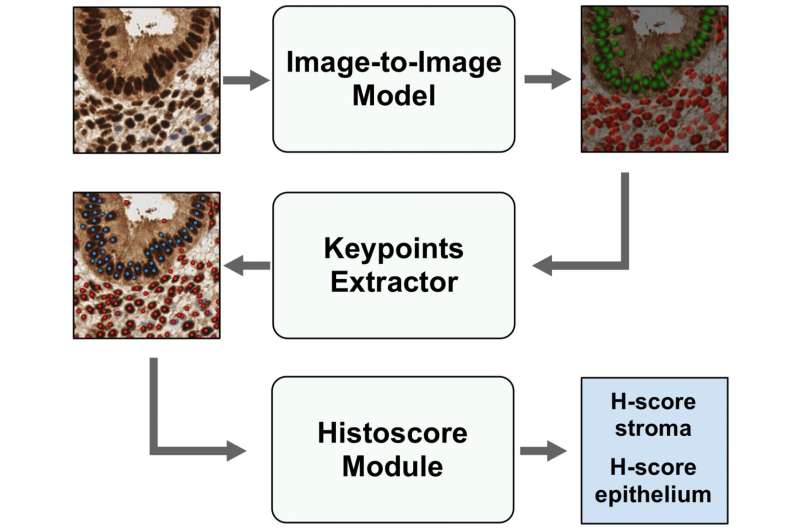This article has been reviewed according to Science X's editorial process and policies. Editors have highlighted the following attributes while ensuring the content's credibility:
fact-checked
trusted source
proofread
Automatic calculation of H-score on histological slides via artificial intelligence

To determine pathological changes in tissues, immunohistochemical studies are used. This is a microscopic examination, for which a thin histological section is made, which is treated with a special substance—an antibody. It interacts with the desired substance in the tissue—for example, protein—and colors it.
This approach is widely used, for example, in oncology, to detect and classify a tumor. The analysis of sections is carried out almost by hand. The histopathologist analyzes the sample and assigns an H-score—a numerical value that reflects the amount of the substance being sought. Even the most experienced professional cannot rule out the possibility of an erroneous diagnosis.
RUDN University doctors, together with the Institute of System Programming of the Russian Academy of Sciences and the Kulakov National Medical Research Center for Obstetrics, Gynecology, and Perinatology, have developed a neural network that will help pathologists quickly and effectively determine the H-score on histological preparations of the endometrium. The study is published in Informatics.
"Analysis of immunohistochemical staining of the endometrium is an extremely important problem. Especially for patients who have suffered miscarriages, infertility, and unsuccessful IVF attempts. The best available tool for this is immunohistochemistry. The immunohistochemical H-score is used to assess the amount and distribution of certain proteins in tissues.
"To do this, the intensity of staining is analyzed and the percentage of stained nuclei is estimated. H-score is widely used but is time-consuming and limited in terms of accuracy. Computer methods can help overcome these limitations and increase the efficiency of pathologists," Polina Vishnyakova, Ph.D., Associate Professor of the Department of Histology, Cytology and Embryology of the RUDN University said.
The model proposed by doctors was named EndoNet. The first part of the name reflects the focus on the endometrium, but the model is not limited to it. EndoNet consists of two parts. The first is a model that predicts important segments of the centers of cell nuclei—this is the detection part of the system. The second part calculates the H-score, for this, it uses the average values from the pixels of previously detected key points.
The model was trained and tested on 1,780 examples of endometrial histological samples measuring 100 by 100 micrometers. On the test data set, the model gave an average accuracy of 77%. For the stroma—the basis of the organ from unformed connective tissue—the accuracy was above 85%.
"The automated H-score calculation system not only speeds up the process but also compensates for errors that may arise, for example, due to different immunostaining approaches. Such a system will also reduce data scattering resulting from different pathologists' calculation biases. EndoNet is a universal algorithm for implementation in any histology department," said Vishnyakova.
More information: Egor Ushakov et al, EndoNet: A Model for the Automatic Calculation of H-Score on Histological Slides, Informatics (2023). DOI: 10.3390/informatics10040090





















